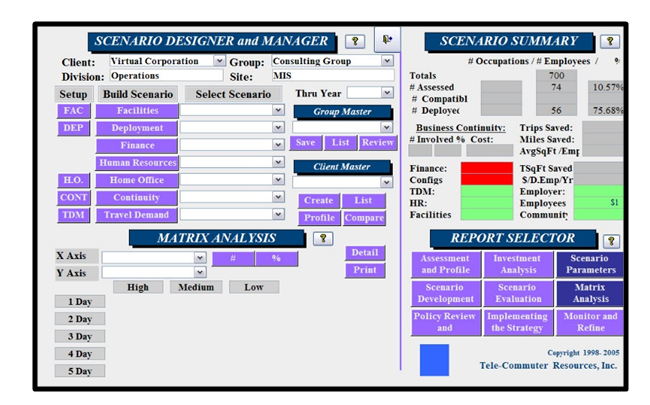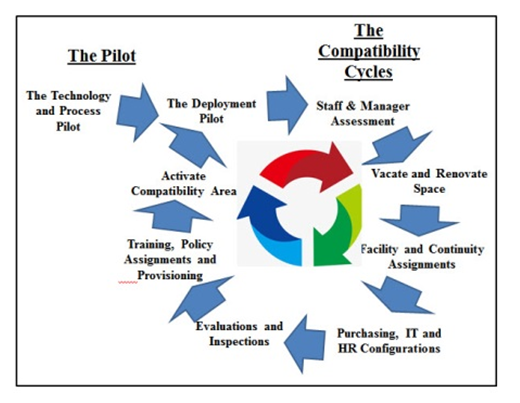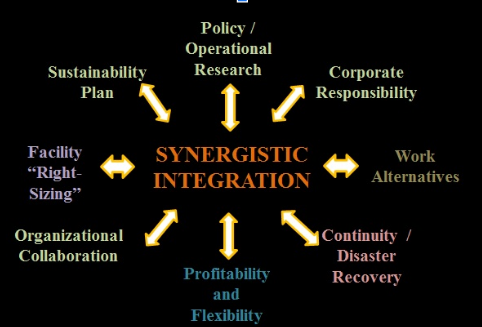As a national response to the pandemic, Tele-Commuter Resources, Inc. seeks to engage the private sector in preparing for the next pandemic as well as ongoing natural disasters. Employers that adopt a strategic telework program not only gain numerous benefits but they are also addressing congestion, climate change, the digital divide and other pressing issues that the public sector has been unable to solve.
The Initiatives’ Goal for the Workforce Virtualization Program
As the first step in the “Beyond the Status Quo” Initiative, our goal is to create a joint venture with key software firms to incorporate their individual applications into our patented Workforce Virtualization Program® (WVP). Each of their “virtualization” releases provides a component of this new management system which collectively enhances their operational and fiscal conditions; provides a strategically defined technology, guidance and working relationships for deployed employees especially when the full continuity/disaster plan component is exercised. Marketed to their client base as a new release, it would be profitable both for the vendors and their clients.
The resulting economic and societal benefits of a massive telework program based upon a “trust but verify” approach, would become a significant economic component of international competitiveness.
The WVPis a comprehensive software product that deploys workers to accomplish:
- Regional Collaborationaggregates employer deployment data to make the region better able to reduce energy, emissions, and congestion. Linking the Information Age concepts of virtualization/SoTAto GIS based trip mitigations opens an entirely new area of policy investigation and cost-cutting opportunities and performance enhancements for employer and agencies a like.
- Facility “right-Sizing” reducesadditional emissions, commute-trips and overhead while standardizing occupation-based work space and technology support configurations organization-wide.
- Continuity /Disaster Recovery provides a virtually-based, multi-level, deployment program that allows an almost instantaneous recovery after a disaster, and
- A six-level accountability programthat objectively measures employee performance and a better focus on achieving both employer and regional goals.
The WVP prototype has been developed to integrate all applicable departments, share, but protect data across all functions and reduce redundancy and inaccuracies. It creates a standardized approach to telework deployments with embedded competitive intelligence, job re-engineering opportunities and it supports the regions in marketing the fiscal benefits as peer pressure to engage more employers.
Background
The Pandemic has taught usthat without theSuite of Telecommuting Applications (SoTA)i.e., telework, e-Commerce, e-learning, telemedicine, etc.our economy would have failed completely. Interestingly, these are the same applications that the government/institutions have been resisting, and in some cases outright blocking, for decades. For telework, government policies at all levels have singularly supported the employee-focused, ad hoc, approach to telework. With the C-Suite generally not engaged in “telework as an employee benefit” program, most transportation coordinators followed the advice of the transit organizations,ad hoc workshops and supporting websites. As a result of this limiting approach, we now have millions of employees working with little or no concern about ergonomics, e.g.,working at breadboards, dining room tables and often with a child on each arm wanting help with e-learning.
As Covid has demonstrated, the ad hoc approach has failed to fulfill the long-heralded employer benefits of increased productivity, space reductions, turnover reductions, reduced overhead and an enhanced scheduling opportunity. As many employers have experienced, the ad hoc approach did not prepare them for the pandemic nor have the ad hoc advocates engaged in the significant role that telework can play in so many other unresolved issues, e.g.,Profitability, Regional Competitiveness, Pandemics, Climate Change, Digital Divide, Quality of Life, Congestion and enhanced personal freedoms.
In contrast, the WVP strategy addresses major impediments which remain prevalent since the 1980s
- Credible ROI– the WVP’s Feasibility Analysis calculates client-verified hard and soft dollar savings. The operating premise is that the more the organization saves from telework, the more teleworkers they would deploy in concert with virtualization policies and employer needs
- Performance Accountability– the 6-source tracking system monitors all aspects of the program to ensure staff, programs, policies and procedures are meeting employer expectations
- Institutional Impediments-this is a leadership issue and a combined public-private sector failure. Due to the manner in which telework has been promoted, the C-Suite has generally not engaged and as a default, lower-level staff has followed the government’s ad hoc training programs and support tools which has created the covid-induced crisis.
No one could have foreseen the massive impact of the pandemic, but with a telework management system in place, employers would have had a significant technologic and organizational structure to execute a response rather than having to createiton the fly. This Initiative provides a method toreinforce not just telework but also the other SoTA as well.
THE WORKFORCE VIRTUALIZATION PROGRAM®(WVP)
The WVP features a comprehensive integration with facilities, finance, purchasing, human resources and information systems. GIS is fully integrated at the employer and regional level for emergency, continuity and traffic management planning. The WVP system uniquely fulfills the telework vision of almost fifty years ago.
While the WVP focuses on the employer’s benefitsit also provides no-cost benefits to the region. Three critical elements apply:
- Vulnerability Audit- TCR’s National Threat Database identifies which static and dynamic events apply to a specific region. GIS plots the impact zones for these threats as well as certain man-made threats in a region; they are also available for participating employers. These plots ensure that teleworkers with continuity roles are located outside of the threat impact area of their office. A critically important element to an immediate recovery response.
- Regional Transportation Interface-By aggregating employer deployment data, the region is better able to reduce energy, emissions and congestion relief; linking the SoTA to GIS based trip mitigations opens an entirely new area of Travel Demand Management
- Freedom of Residential Choice– With scheduled staff remote assignments, assigned employees increasingly have the option of choosing urban neighborhood or rural community.
Following the 9/11 recommendations, the WVP’s strategically designed virtual disaster recovery program distributes employer assets while enhancing their viability and contributing significantly to the employer’s facility “right-sizing” / overhead reduction plan.
A key element in the WVP’s planning process is the Modeling Screen; it is used to calculate the impacts on key employer components by “mixing and matching” scenario combinations. Those combinations that best support the program’s goals and guidelines are saved for senior management review and plan selection. After the full Deployment Plan is completed, the Modeling Screen is again used to verify that the original results remain valid.
Once the Deployment Plan is in place, the Implementation Cycle begins. Following the strategically designed Pilot, each subsequent Implementation Cycle is executed, i.e., deploy staff, convert facilities.


KEY CAPABILITIES OF THE WORKFORCE VIRTUALIZATION PROGRAM
- Feasibility Analysis
- Occupational Assessment profiles each occupation to determine deployment potential while providing modeling data to determine space reduction potential
- Managerial Assessment explores manager awareness of the 24 areas in which telework can support an organization; results form the basis for the training program
- The Feasibility Report quantifies deployment potential and calculates departmental impacts to which the department heads respond with their costs and readiness
- The GO, NO-GO Decisionresults from a senior management workshop which determines if the organization wishes to proceed, and, if so, the program is configured, setting goals and deployment guidelines
- Mitigation Investment Analysis
- Evaluates the Assessment-identified deployment barriersare reviewed to determine the savings resulting from various mitigations; potential deployment levels are increased
- Facility profiles all existing workstation and technology needs as a pre-cursor to establishing workstation standards based upon WVP’s Worker Typology
- Installation Sequence defines staff roles, data access, software installation; staff rates and availability are assigned to determine the WVP’s installation cost and schedule
- Scenario Analysis and Modeling
- Develop multiple scenarios for finance, staff deployment, provisioning configurations- definition and budget, facility standards, continuity deployment requirements, configurations, travel demand management options
- Modeling Calculationson various scenario combinations identifies multiple operational impacts, i.e., facilities, deployments, finance, provisioning, commute impacts etc.
- Master Scenario Selection Management Team selects optimal program plan
- Policy Review and Development
- Implementation Team develops /modifies seven operational policy sets; traditional ad hoc “formal telework agreement” is incorporated into the Home Guidelines Manual
- Detailed Functional Plans are developed for Deployment, Facilities, Conversion, Continuity, Purchasing, Training and Travel Demand Management
- Implementation Program
- Staff Selection with compatibility assessments for candidates and managers
- Candidate Assignment meets HR for policy, schedule and training; IT for provisioning, optional COOP assignment, security configurations and training; Purchasing for provisioning, installation and inspection; Facilities for on-site, off-site and temporary workstation assignments and the Manager to execute the employee’s Deployment Agreement with specific policies, schedules, work assignments and expectations
- Strategic Pilotinitial deployment tests all configurations and validates processes
- Execute Deployment Cycles manages the facility conversion, staffing deployment and initiates Readiness Process to set date for next Cycle
- Monitor Refinement Program
- Deployment Partnership– integration with Metropolitan Planning Organizations
- Research Partnership– integration with TCR’s National Policy and Best Practice research
- Managerial Inquiry Screens– uniquely display and link data for detailed inquiriesby managers
- Staff Selection with compatibility assessments for candidates and managers

